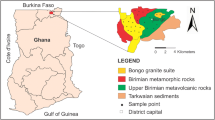Abstract
Hydrochemical data are presented for groundwater samples, collected from fractured aquifers in parts of northern Ghana. The data was collected to assess the groundwater suitability for domestic and agricultural use. Results of the study reveal that the pH of the groundwater in the area is slightly acidic to slightly alkaline. The electrical conductivity values, total dissolved solids (TDS) values and calcium, magnesium and sodium concentrations in the groundwater are generally below the limit set by the WHO for potable water supply. On the basis of activity diagrams, groundwater from the fractured aquifers appears to be stable within the montmorillonite field, suggesting weathering of silicate minerals. An inverse distance weighting interpolator with a power of 2 was applied to the data points to produce prediction maps for nitrate and fluoride. The distribution maps show the presence of high nitrate concentrations (50–194 mg/l) in some of the boreholes in the western part of the study area indicating anthropogenic impact on the groundwater. Elevated fluoride level (1.5–4 mg/l), higher than the WHO allowable fluoride concentration of 1.5, is recorded in the groundwater underlying the northeastern part of the study area, more specifically Bongo and its surrounding communities of the Upper East region. Results of this study suggest that groundwater from the fractured aquifers in the area exhibit low sodicity–low salinity (S1–C1), low sodicity–medium salinity (S1–C2) characteristics [United States Salinity Laboratory (USSL) classification scheme]. All data points from this study plot within the ‘Excellent to good’ category on a Wilcox diagram. Groundwater in this area thus appears to provide irrigation water of excellent quality. The hydrochemical results indicate that, although nitrate and fluoride concentrations in some boreholes are high, the groundwater in the study area, based on the parameters analyzed, is chemically potable and suitable for domestic and agricultural purposes.










Similar content being viewed by others
References
Apambire NB, Boyle R, Michel FA (1997) Geochemistry, genesis, and health implication of Fluoriferous groundwaters in the upper region of Ghana. Environ Geol 33:13–24
Appelo CAJ, Postma D (2005) Geochemistry, groundwater and pollution, 2nd edn. A.A, Balkema, Rotterdam
Banoeng-Yakubo BK (1989) Occurrence of groundwater in basement complex rocks of the Upper Regions of Ghana. Unpublished M. Sc. Thesis, Geology Department, Obafemi-Awolowo University
Banoeng-Yakubo BK (2000) The application of remote sensing and geographical information systems to hydrogeological studies in the Upper West Region, Ghana. Unpublished Ph.D. Thesis, Geology Department, University of Ghana
Barnes CJ, Jacobson G, Smith DG (1992) The origin of high-nitrate groundwaters in the Australian arid zone. J Hydrol 137:181–197
Chapman D (1992) Water quality assessments, 2nd edn. E&FN Spon, an imprint of Chapman & Hall, London
CIDA/GWSC (1980) Final hydrogeological report for drilling program 1974–1979. A report prepared by Wardrop and Associates for Ghana Water and Sewerage Corporation and Canadian International Development Agency
Davis SN, De Wiest RJM (1966) Hydrogeology. John Wiley and Sons, New York
Dickson KB, Benneh G (1980). A new geography of Ghana, metricated edn. Longman, London
Dissanayake CB (1991) The fluoride problem in the groundwater of Sri Lanker-environmental management and health. Int J Environ Stud 19:195–203
Driscoll FG (1989) Groundwater and wells, 2nd edn. Johnson Filtration System Inc, St. Paul, MN, USA
Edet A, Okereke C (2005) Hydrogeological and hydrochemical character of the regolith aquifer, northern Obudu Plateau, southern Nigeria. Hydrogeol J 13:391–415
Edmunds WM, Gaye CB (1997) High nitrate baseline concentrations in groundwaters from the Sahel. J Environ Qual 26:1231–1239
Fetter CW (1994) Applied hydrogeology, 3rd edn. Macmillan College Publication, New York
Freeze AR, Cherry JA (1979) Groundwater. Prentice-Hall, NJ, USA
Glover CR (1996) Irrigation water classification systems. Guide A-116. Cooperative Extension Service, College of Agriculture and Home Economics, New Mexico State University
Hem JD (1985) Study and interpretation of chemical characteristics of natural waters. US geological survey water supply paper 2254
Hem JD (1989) Study and interpretation of chemical characteristics of natural waters, 3rd edn. US geological survey water supply paper 2254
Junner NR (1940) Geology of the Gold Coast and Western Togoland. Accra Geol Surv Bull 11:45
Kesse GO (1985) The mineral and rock resources of Ghana. A.A, Balkema, Rotterdam
Kortatsi BK (2004) Hydrochemistry of groundwater in the mining area of Tarkwa-Prestea, Ghana. PhD, University of Ghana, Ghana
Leube A, Hirdes W, Mauer R, Kesse GO (1990) The early Proterozoic Birimian Supergroup of Ghana and some aspects of its associated gold mineralization. Precambrian Res 46:139–165
MacDonald A, Davis J, Calow R, Chilton J (2005) Developing groundwater: a guide for rural water supply. ITDG Publishing, Rugby, UK
McLean W, Jankowski J, Lavitt N (2000) Groundwater quality and sustainability in an alluvial aquifer, Australia. In: Sililo et al (eds) Proceedings of the XXX IAH congress on groundwater: past achievements and future challenges. A.A., Balkema, Rotterdam, pp 567–573
Norgbe BY (1996) Evaluation of the hydrogeological relationship between monitoring and productive boreholes in the Upper West Region, Ghana. MPhil, University of Ghana, Ghana
Norton D (1974) Chemical mass transfer in the RioTanama System, west-central Puerto Rico. Geochim Cosmochim Acta 38:267–277
Sen Z, Al-Dakheel A (1986) Hydrochemical facies evaluation in Umm Er Radhuma Limestone eastern Saudi Arabia. Ground Water 24:626–635
Todd DK (1980) Groundwater Hydrology, 2nd edn. John Wiley and Sons, New York
USSL (1954) Diagnosis and improvement of saline and alkali soils. USDA Agr. Handbook No. 60, Washington DC
Wilcox IV (1955) Classification and use of irrigation water. USDA Circ. 696, Washington DC
World Health Organization (1984) Guidelines for drinking water quality, vol 1. Recommendations. Geneva, Switzerland
Yidana SM, Ophori D, Banoeng-Yakubo B (2008a) Hydrogeological and hydrochemical characterization of the Voltaian Basin: the Afram Plains area. Environ Geol 53:1213–1223. doi:10.1007/s0254-007-0710-1
Yidana SM, Ophori D, Banoeng-Yakubo B (2008b) Groundwater quality evaluation for productive uses—the Afram Plains area, Ghana. J Irrigation Drainage Eng 134:222–227
Author information
Authors and Affiliations
Corresponding author
Rights and permissions
About this article
Cite this article
Anku, Y.S., Banoeng-Yakubo, B., Asiedu, D.K. et al. Water quality analysis of groundwater in crystalline basement rocks, Northern Ghana. Environ Geol 58, 989–997 (2009). https://doi.org/10.1007/s00254-008-1578-4
Received:
Accepted:
Published:
Issue Date:
DOI: https://doi.org/10.1007/s00254-008-1578-4




